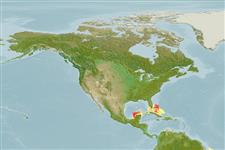>
Ophidiiformes (Cusk eels) >
Bythitidae (Livebearing brotulas)
Etymology: Lucifuga: Latin, lux = light + latin, fugere = to escape, to avoid, to run away from (Ref. 45335); lucayana: Named for its type locality, Lucayan Caverns, graveyard of the Lucayan Indians who inhabited the Bahamas for 2000 years and were eliminated by the European invaders..
More on authors: Møller, Schwarzhans, Iliffe & Nielsen.
Environment: milieu / climate zone / depth range / distribution range
Ecología
marino bentopelágico; rango de profundidad 12 - 20 m (Ref. 57878). Subtropical
Distribución
Países | Áreas FAO | Ecosistemas | Ocurrencias, apariciones | Point map | Introducciones | Faunafri
Western Atlantic: Caribbean, Bahamas.
Tamaño / Peso / Age
Maturity: Lm ? range ? - ? cm
Max length : 9.9 cm SL (female)
Short description
Claves de identificación | Morfología | Morfometría
Radios blandos dorsales (total) : 84 - 91; Radios blandos anales: 63 - 69; Vértebra: 50 - 52. This species is distinguished from its congeners by the following combination of characters: Vertebrae 12-13+37-39=50-52, dorsal fin rays 84-91, anal fin rays 63-69, pectoral fin rays 17-18, caudal fin rays 10; head profile above eye strongly depressed, scales on occiput, eyes present (0.9-1.0 % SL); palatine teeth absent; color uniformly light brown, long gill-rakers 3, pale (Ref. 57878).
Found in an anchialine cave which is connected to the sea via a submerged passage which opens into a tidal saltwater creek. The upper about 14 m in the cave consists of freshwater (22 °C), separated from a lower, slightly warmer (23-25 °C), salty layer by a distinct halocline. The holotype was taken in a depth of 12 m, which must then most likely to be freshwater; some where collected from one or two inland sink holes (Ref. 57878).
Life cycle and mating behavior
Maturities | Reproducción | Spawnings | Egg(s) | Fecundities | Larva
Møller, P.R., W. Schwarzhans, T.M. Iliffe and J.G. Nielsen, 2006. Revision of the Bahamian cave-fishes of the genus Lucifuga (Ophidiiformes, Bythitidae), with description of a new species from islands on the Little Bahama Bank. Zootaxa 1223:23-46. (Ref. 57878)
IUCN Red List Status (Ref. 130435)
Threat to humans
Harmless
Human uses
Herramientas
Special reports
Download XML
Fuentes de Internet
Estimates based on models
Preferred temperature (Ref.
123201): 26.3 - 28, mean 27 °C (based on 198 cells).
Phylogenetic diversity index (Ref.
82804): PD
50 = 0.5078 [Uniqueness, from 0.5 = low to 2.0 = high].
Bayesian length-weight: a=0.00457 (0.00179 - 0.01169), b=3.10 (2.87 - 3.33), in cm total length, based on LWR estimates for this (Sub)family-body shape (Ref.
93245).
Nivel trófico (Ref.
69278): 3.3 ±0.5 se; based on size and trophs of closest relatives
Resiliencia (Ref.
120179): Alto, población duplicada en un tiempo mínimo inferior a 15 meses (Preliminary K or Fecundity.).
Fishing Vulnerability (Ref.
59153): Low vulnerability (10 of 100).
